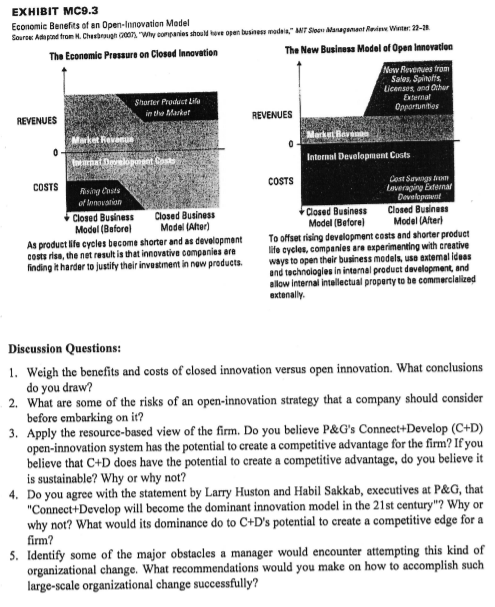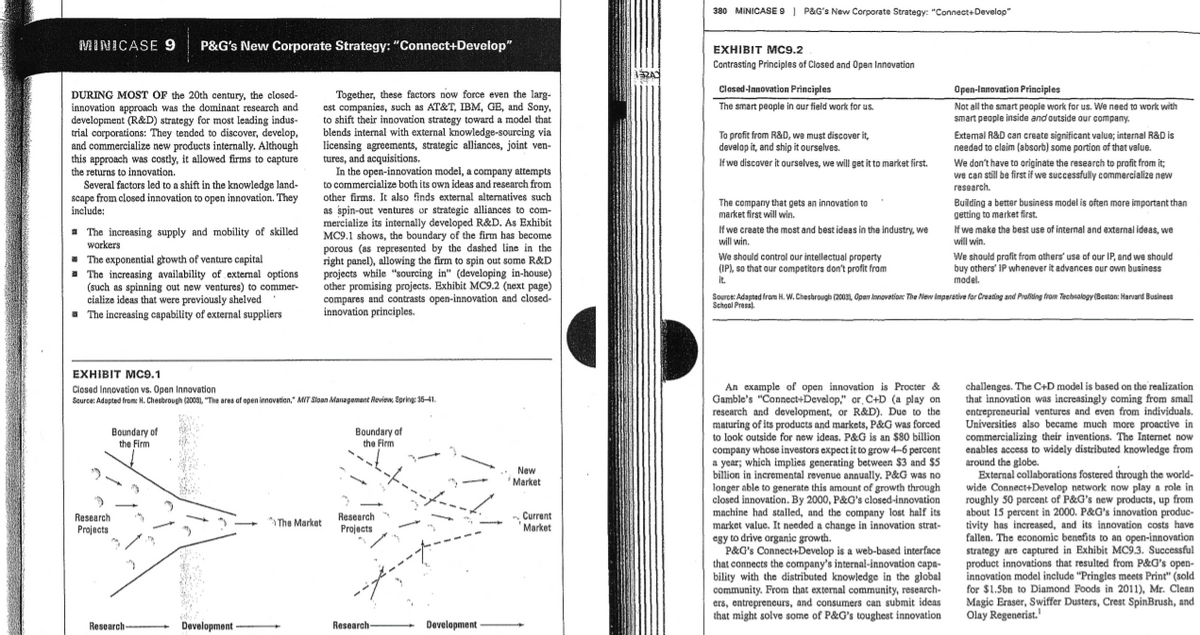Economic Benefits of an Open-Innovatlon Madel Saure Adad to Deg n Wy ureaies houlhe pe sine deMT Saaganat ei Wee 2-a The Economic Presure on Closed Innovation The New Busines Model of Open Innovation New Revenues trom Sales. Spine Licensen and Oher Eternal Opportunties Sharter Product i in the Market REVENUES REVENUES t Cost Internal Development Costs COSTS Cest Sags Ivenging Etena Devekpt Closed Business Model Ater COSTS Roing Costa of Inovation Cosed Business Model (Before) Closed Business Model (Beforel As product ife cycles become shorter and as development costs risa, the net result is that innovative companies are finding it harder to justify their investment in new products. Closed Business Model (Aher) To offset rising devalopment costs and shorter produ life cycles, companies are experimenting with creati ways to open their business models, use temal ida achoeioales in intenal product development, a
Economic Benefits of an Open-Innovatlon Madel Saure Adad to Deg n Wy ureaies houlhe pe sine deMT Saaganat ei Wee 2-a The Economic Presure on Closed Innovation The New Busines Model of Open Innovation New Revenues trom Sales. Spine Licensen and Oher Eternal Opportunties Sharter Product i in the Market REVENUES REVENUES t Cost Internal Development Costs COSTS Cest Sags Ivenging Etena Devekpt Closed Business Model Ater COSTS Roing Costa of Inovation Cosed Business Model (Before) Closed Business Model (Beforel As product ife cycles become shorter and as development costs risa, the net result is that innovative companies are finding it harder to justify their investment in new products. Closed Business Model (Aher) To offset rising devalopment costs and shorter produ life cycles, companies are experimenting with creati ways to open their business models, use temal ida achoeioales in intenal product development, a
Principles of Economics 2e
2nd Edition
ISBN:9781947172364
Author:Steven A. Greenlaw; David Shapiro
Publisher:Steven A. Greenlaw; David Shapiro
Chapter10: Monopolistic Competition And Oligopoly
Section: Chapter Questions
Problem 21P: Jane and Bill are apprehended for a bank robbery. They are taken into separate rooms and questioned...
Related questions
Question
100%

Transcribed Image Text:EXHIBIT MC9.3
Economic Benefits of an Open-lnnovation Model
Souroe: Adapond tron H. Chesbrough G00n "Wy companies should hove open business modeia," MIT Slo Managanant Reine Weter: 22-2
The Economic Pressure on Closod Innovation
The New Business Model of Open Innovation
Nuw Revenues trom
Sales, Spinofts
Licanses, and Othar
Externat
Sharter Product Lifa
in the Market
Oppartunities
REVENUES
REVENUES
Revanun
urnat Developonent
Intornal Development Costs
Cost Savngs tom
Laveraging External
Developawnt
Closed Business
Model (After
To offset rising development costs and shorter product
life cycles, companies are experimenting with creative
ways to open their business models, use extemal ideas
and technologies in internal product development, and
allow internal intellectual property to be commercialized
COSTS
COSTS
fising Cnsts
of lonovation
Closed Business
Model (Beforel
As product life cycles become shorter and as development
costs risa, the net result is that innovative companies ere
finding it harder to justify their investment in new products.
Closed Business
Model (Ater)
Closed Business
Model (Before)
extenally.
Discussion Questions:
1. Weigh the benefits and costs of closed innovation versus open innovation. What conclusions
do you draw?
2. What are some of the risks of an open-innovation strategy that a company should consider
before embarking on it?
3. Apply the resource-based view of the firm. Do you believe P&G's Connect+Develop (C+D)
open-innovation system has the potential to create a competitive advantage for the firm? If you
believe that C+D does have the potential to create a competitive advantage, do you believe it
is sustainable? Why or why not?
4. Do you agree with the statement by Larry Huston and Habil Sakkab, executives at P&G, that
"Connect+Develop will become the dominant innovation model in the 21st century"? Why or
why not? What would its dominance do to C+D's potential to create a competitive edge for a
firm?
5. Identify some of the major obstacles a manager would encounter attempting this kind of
organizational change. What recommendations would you make on how to accomplish such
large-scale organizational change successfully?

Transcribed Image Text:380 MINICASE 9 PaG's New Corporate Strategy: "Connect+Develop"
MINICASE 9
P&G's New Corporate Strategy: "Connect+Develop"
EXHIBIT MС9.2
Contrasting Principles of Closed and Open Innovation
Closed-Innovation Principles
Open-Innovation Principles
Together, these factors now force even the larg-
est companies, such as AT&T, IBM, GE, and Sony,
to shift their innovation strategy toward a model that
blends internal with external knowledge-sourcing via
licensing agreements, strategic alliances, joint ven-
tures, and acquisitions.
In the open-innovation model, a company attempts
to commercialize both its own ideas and research from
other firms. It also finds external alternatives such
as spin-out ventures or strategic alliances to com-
mercialize its internally developed R&D. As Exhibit
MC9.1 shows, the boundary of the firm has become
porous (as represented by the dashed line in the
right panel), allowing the firm to spin out some R&D
projects while "sourcing in" (developing in-house)
other promising projects. Exhibit MC9.2 (next page)
compares and contrasts open-innovation and closed-
innovation principles.
DURING MOST OF the 20th century, the closed-
innovation approach was the dominant research and
development (R&D) strategy for most leading indus-
trial corporations: They tended to discover, develop,
and commercialize new products internally. Although
this approach was costly, it allowed firms to capture
the returns to innovation.
The smart people in aur field work for us.
Not all the smart people work for us. We need to work with
smart people inside and outside our company.
To profit from R&D, we must discover it,
develop it, and ship it ourselves.
Extemal R&D can create significant value; internal R&D is
needed to claim (absorb) some portion of that value.
If we discover it ourselves, we will get it to market first.
We don't have to originate the research to profit from it;
we can still be first if we successfully commercialize new
research.
Several factors led to a shift in the knowledge land-
scape from closed innovation to open innovation. They
include:
The company that gets an innovation to
market first will win.
Building a better business model is often more important than
getting to market first.
1 The increasing supply and mobility of skilled
workers
a The exponential growth of venture capital
- The increasing availability of extemal options
(such as spinning out new ventures) to commer-
cialize ideas that were previously shelved
a The increasing capability of external suppliers
If we create the most and best ideas in the industry, we
will win.
If we make the best use of internal and external ideas, we
will win.
We should control our intellectual property
(IP), so that our competitors don't profit from
it.
We should profit from others' use of our IP, and we should
buy others' IP whenever it advances our own business
model.
Source: Adapted from H. W. Chesbrough (2003I, Opan ianovation: The New imperative for Creating and Profiing trom Technology (Bestan: Harvard Business
School Press).
EXHIBIT MC9.1
An example of open innovation is Procter &
Gamble's "Connect+Develop," or, C+D (a play on
research and development, or R&D). Due to the
maturing of its products and markets, P&G was forced
to look outside for new ideas. P&G is an $80 billion
company whose investors expect it to grow 4-6 percent
a year; which implies generating between $3 and $5
billion in incremental revenue annually. P&G was no
longer able to generate this amount of growth through
closed innovation. By 2000, P&G's closed-innovation
machine had stalled, and the company lost half its
market value. It needed a change in innovation strat-
egy to drive organic growth.
P&G's Connect+Develop is a web-based interface
that connects the company's internal-innovation capa-
bility with the distributed knowledge in the global
community. From that external community, research-
ers, entrepreneurs, and consumers can submit ideas
that might solve some of P&G's toughest innovation
challenges. The C+D model is based on the realization
that innovation was increasingly coming from small
entrepreneurial ventures and even from individuals.
Universities also became much more proactive in
commercializing their inventions. The Internet now
enables access to widely distributed knowledge from
around the globe.
External collaborations fostered through the world-
wide Connect+Develop network now play a role in
roughly 50 percent of P&G's new products, up from
about 15 percent in 2000. P&G's innovation produc-
tivity has increased, and its innovation costs have
fallen. The economic benefits to an open-innovation
strategy are captured in Exhibit MC9.3. Successful
product innovations that resulted from P&G's open-
innovation model include "Pringles meets Print" (sold
for $1.5bn to Diamond Foods in 2011), Mr. Clean
Magic Eraser, Swiffer Dusters, Crest SpinBrush, and
Olay Regenerist.
Closed Innovation vs. Open Innovation
Source: Adapted from: H. Chasbrough (200S1, "The ares of open innovation," MIT Sloan Managemant Review, Spring: 35-41.
Boundary of
the Firm
Boundary of
the Firm
New
Market
Research
Projects
Research
Projects
Current
Market
The Market
Research
Development
Research-
Development
Expert Solution
This question has been solved!
Explore an expertly crafted, step-by-step solution for a thorough understanding of key concepts.
Step by step
Solved in 3 steps

Knowledge Booster
Learn more about
Need a deep-dive on the concept behind this application? Look no further. Learn more about this topic, economics and related others by exploring similar questions and additional content below.Recommended textbooks for you

Principles of Economics 2e
Economics
ISBN:
9781947172364
Author:
Steven A. Greenlaw; David Shapiro
Publisher:
OpenStax

Managerial Economics: A Problem Solving Approach
Economics
ISBN:
9781337106665
Author:
Luke M. Froeb, Brian T. McCann, Michael R. Ward, Mike Shor
Publisher:
Cengage Learning


Principles of Economics 2e
Economics
ISBN:
9781947172364
Author:
Steven A. Greenlaw; David Shapiro
Publisher:
OpenStax

Managerial Economics: A Problem Solving Approach
Economics
ISBN:
9781337106665
Author:
Luke M. Froeb, Brian T. McCann, Michael R. Ward, Mike Shor
Publisher:
Cengage Learning



Microeconomics: Principles & Policy
Economics
ISBN:
9781337794992
Author:
William J. Baumol, Alan S. Blinder, John L. Solow
Publisher:
Cengage Learning

Exploring Economics
Economics
ISBN:
9781544336329
Author:
Robert L. Sexton
Publisher:
SAGE Publications, Inc